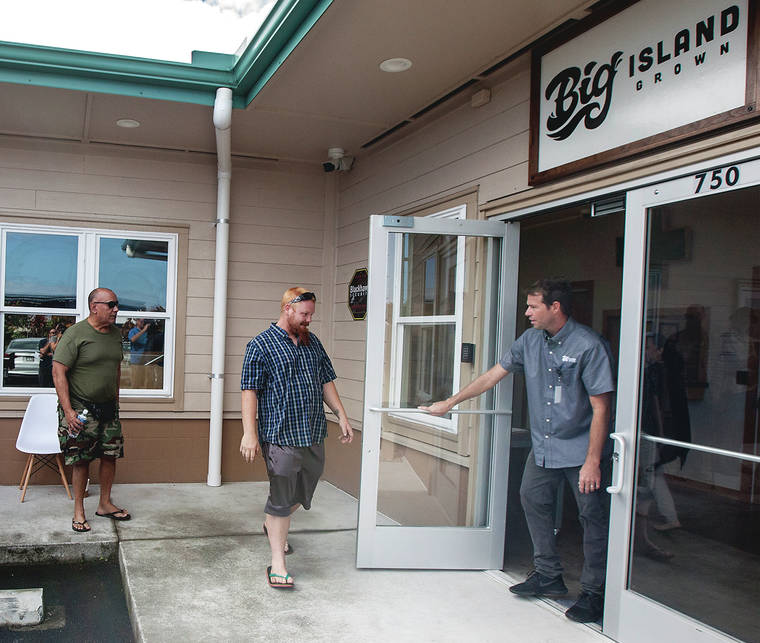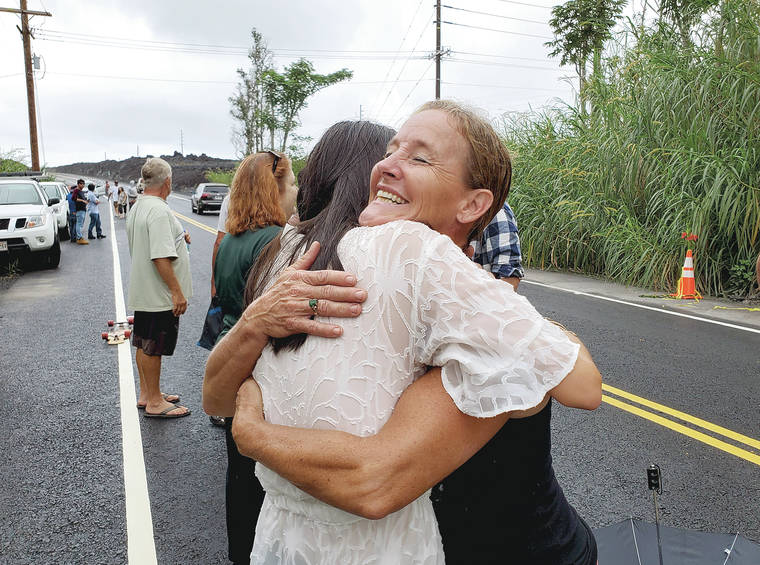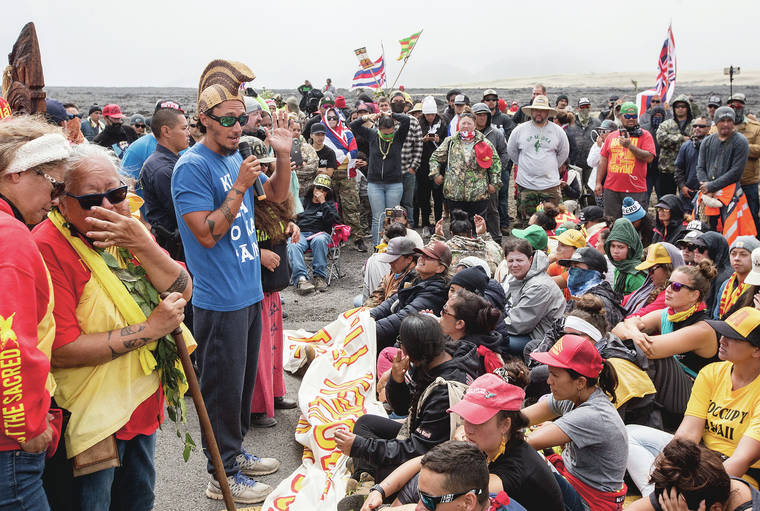 Big Island Grown’s first customer is greeted on Jan. 16 in Hilo. (Tribune-Herald file photo)
Big Island Grown’s first customer is greeted on Jan. 16 in Hilo. (Tribune-Herald file photo) Puna Councilwoman Ashley Kierkiewicz hugs Kapoho resident Smiley Burrows at the reopening of Highway 132 in November. (STEPHANIE SALMONS/Tribune-Herald)
Puna Councilwoman Ashley Kierkiewicz hugs Kapoho resident Smiley Burrows at the reopening of Highway 132 in November. (STEPHANIE SALMONS/Tribune-Herald) Kahookahi Kanuha talks with TMT opponents in July on the Maunakea Access Road. (Tribune-Herald file photo)
Kahookahi Kanuha talks with TMT opponents in July on the Maunakea Access Road. (Tribune-Herald file photo)
It’s time to bid aloha to 2019 and leap into both a new year and a new decade. And this year, that “leap” is literal — 2020 is a leap year, meaning February will have an extra day.
As in any year, in 2019 there were a number of notable Big Island people who took their final bows. They include: KTA Super Stores chairman and community benefactor Barry Taniguchi; former County Parks and Recreation Director George Yoshida, who became a public figure as co-host of KTA’s “Seniors Living in Paradise” public access TV program; Elroy Osorio, former County Board of Supervisors chairman and councilman, beloved volleyball official and sportsman; radio and television personality Jacqueline “Skylark” Rossetti, who had a longtime association with the Merrie Monarch Festival; “Aunty Maile” Mauhili, a prominent canoe paddler, coach and race organizer as well as longtime security presence on the Hilo High School campus; and William “Will” Ing, a retired Hawaii Tribune-Herald photographer who took the newspaper’s images from the darkroom to the digital age.
Hawaii Island’s art community was especially hard hit in 2019 by the deaths of artists Linus Chao, Robert Thomas Kitchen and Shingo Honda — all of whom will long be remembered through their work.
Here are the top 10 stories of 2019, as selected by the editorial staff of the Tribune-Herald.
1. Standoff on the mauna
On July 10, Gov. David Ige, announced construction of the long-delayed Thirty Meter Telescope on Maunakea would start on July 15, a Monday. That weekend, hundreds of opponents of the $1.4 billion next-generation telescope gathered at Pu‘u Huluhulu, across Daniel K. Inouye Highway from Maunakea Access Road. On July 15, protesters — who call themselves kia‘i, or protectors of Maunakea, which many Hawaiians consider sacred — took to the access road, as they did in 2015, for peaceful demonstrations. On July 17, 38 protesters, mainly kupuna, or elders, were arrested and charged with petty misdemeanor obstruction charges. Their cases are still in Hilo District Court. The arrests did nothing to deter the protests, as the blockade of the road continued, operations at existing observatories were curtailed until agreements were later reached — and construction trucks, workers and materials still haven’t scaled the mountain. As many as 3,000 were estimated at the protest site on some weekends as the movement gained traction via social media. Celebrities, including actors Jason Momoa and Dwayne “The Rock” Johnson and musicians Jack Johnson and Damien Marley, visited the mauna to show their support. Ige declared a state of emergency, which would allow him to activate the Hawaii National Guard, although mobilization of citizen-service members didn’t take place. He also accused protest leaders of using social media to “spread rumors and fear, rather than engage in real world conversations about how we can move forward together.” Ultimately, Ige visited the protest site with Mayor Harry Kim and turned over negotiations with leaders to the mayor. Kim published a pamphlet, titled “Heart of Aloha — Maunakea: A Way Forward,” and remains steadfast in his belief a compromise can be reached that moves the project forward while still satisfying the concerns of opponents — a position that has, so far, been a nonstarter with those opposed to TMT. On Aug. 15, police began what they called “enhanced traffic enforcement” on the highway near the access road. Police said the effort was for “the safety of motorists and pedestrians alike,” but opponents said it was aimed at them and was an attempt to quell the protests. In an 18-week period ending Dec. 18, the police detail issued 8,324 traffic citations and arrested 78 people for 143 offenses. The county has racked up about $5 million in expenditures related to TMT enforcement, and Assistant Chief Samuel Thomas told the Police Commission on Dec. 20 the department is $3 million over budget, mostly because of police overtime related to the enforcement. The County Council rejected a five-year, $10 million deal offered by the state to reimburse the county for TMT expenses because of ambiguous terms and the open-ended nature of the deal. Ige announced the reopening of the access road on Dec. 20 and gave those camped there a deadline of Dec. 26 to clear it or face consequences. Kim called the deadline “not a significant date” and struck a deal with protest leaders — whom he called “protectors” — to clear the road after promising no construction activity or attempts to remove protesters from their camp until at least the end of February 2020.
2. Lava recovery
The eruption of Kilauea volcano that covered almost 14 square miles of land, destroyed more than 700 homes and structures, and displaced about 3,000 residents in lower Puna officially ended on Oct. 5, 2018, but the recovery process was still in the beginning stages in 2019. According to the county’s Kilauea Eruption Recovery website, the eruption caused $27.9 million in farm losses and $415 million in lost tourism revenue. The county contracted the Institute for Sustainable Development, a nonprofit organization based in Alexandria, Va., to do an in-depth assessment of the eruption’s economic impacts and draft an economic recovery plan. ISD’s $498,500 contract is being covered by the U.S. Department of Commerce’s Economic Development Administration and the state. The county’s Disaster Recovery Task Force — which consists of representatives from the county administration, County Council and the community — held its first meeting Dec. 12 and will begin reviewing proposed strategies from the draft recovery strategic plan in January, Disaster Recovery Officer Douglas Le said. The task force will focus on areas including housing, health and social services, infrastructure, economic recovery, natural and cultural resources and community planning. Highway 132, a major artery in lower Puna, was restored to its pre-inundation function and reopened in late November. A 1.6-mile stretch of the upper portion of the highway and a 1.5-mile section of the lower portion of the road were covered in lava, leaving a kipuka, an isolated area surrounded by lava, in the mid-section of the highway. A 1,100-foot section of Government Beach Road from “Four Corners” — the intersection of Highway 132 and Highway 137 — to the lava inundation also was restored. High temperatures of the lava rock that covered more than three miles of the highway delayed work on the roadway. The county said the Federal Highways Administration will reimburse the county the $6.5 million it cost to repave and reopen the road. Also reopened in 2019 include a rougher portion of Highway 137 and Isaac Hale Beach Park in Pohoiki. The state boat ramp in Pohoiki is still cut off by a newly formed black sand beach and an alternative to the only boat ramp between Hilo and Milolii are still being sought. And Puna Geothermal Venture, the state’s only geothermal power plant, is hoping to sell electricity again in early 2020. Lava destroyed a substation and covered a few geothermal wells, as well as cutting off road access to the plant. It was otherwise spared significant damage in the eruption.
3. Reduce, reuse, recycle?
Public service announcements run on radio and TV urge residents to “reduce, reuse, recycle,” but recent developments had some scratching their heads and asking, “How?” The county’s Department of Environmental Management said in late October the lack of an overseas market for mixed recycling caused it to stop accepting plastic, office paper and newspapers at county transfer stations. Metal cans are being accepted at scrap metal bins. And HI-5 cans and plastic bottles continue to be accepted at HI-5 redemption centers. A Facebook group called Puna Precious Plastic has grown to more than 1,000 members and is now collecting non-HI-5 plastics. There are also chapters of Zero Waste Big Island, which is trying to limit the amount of plastics being used to begin with in Hilo and Kona. The county’s polystyrene ban, which outlaws Styrofoam food containers, went into effect on July 1, which requires the use of compostable containers certified by the Biodegradable Product Institute, or BPI, but the county doesn’t plan to open an industrial composting facility until July 1, 2020. The county’s polystyrene ban doesn’t include items shipped into the state, which are covered by interstate commerce laws, food packaged outside the county, and packaging for raw meat, fish and eggs that haven’t been further processed. And the 392-page Integrated Solid Waste Management Plan unveiled Dec. 8 makes 82 specific recommendations for changes to the county’s waste management systems. The plan is still a draft version, and public comments are open until Feb. 4, with public hearings Jan. 21 in Hilo and Jan. 23 in Kona.
4. Short-term rental law a red-tape special
The county’s new short-term vacation rental law went into effect in April. The law prohibits rentals for less than 30 days outside resort zones on properties with no more than five bedrooms and where the owner doesn’t reside. Owners of short-term rentals in excluded zones had a Sept. 30 deadline to apply for a nonconforming use permit. The rules — which required applicants to submit approved building, plumbing and electrical permits, building diagrams, proof of property taxes, certification for parking, verification that notices of the business were submitted to all neighbors within 300 feet of the property and noise limitations, with a $500 nonrefundable application fee and $250 yearly renewal fees — drove some short-term vacation rental owners out of business. The county’s Planning Department said in early November it was having trouble plowing through almost 4,000 applications, including 1,150 seeking exemptions for nonconforming zoning — about five times the number of applications of all types it normally receives in a year. Planning Director Michael Yee told council members in November only 900 applications had been processed, and 80 or 90 permits were denied. Yee said about a third of the properties seeking nonconforming use permits have drawn more than 1,000 complaints. “Regular working people don’t want vacation rentals in their neighborhoods,” Yee said. A multi-agency software system designed to streamlining the planning and building permit process is still in the works, but rollout isn’t expected until March.
5. Hot, hot, hot!
Hawaii, including the Big Island, saw record high temperatures hit the books at a dizzying pace through the summer and much of the fall. July was the hottest month on record worldwide, according to the National Oceanic and Atmospheric Administration. In July, Hilo’s average high temperature was 85.3 degrees, 2.5 degrees above the norm of 82.8 degrees and 0.4 degrees higher than last year’s July average of 84.9 degrees. For the summer, Hilo International Airport recorded 16 high-temperature records tied or broken, largely because of higher-than-normal ocean surface temperatures, according to the National Weather Service. On Oct. 9, Hilo hit 90 degrees, eclipsing the previous high of 89 for the date set in 1979 Record temps also were tied or broken on Nov. 2, 4, 5, 6, 9, 10, 11, 12, 13 and 14. On Nov. 18, Sony Vang, Pacific region climates officer for NWS, said 21 high-temperature records had been broken in Hilo compared to five all year in 2018.
6. Gimme shelter
The yearly Point In Time count indicates homelessness was down in 2019 compared to 2018 on Hawaii Island, but that would be a hard sell to anyone walking around downtown Hilo or Kailua-Kona. According to the count, which asked homeless people “where did you sleep on January 22?” it would appear homelessness decreased substantially on the Big Island, from 869 individuals in 2018 to 690 in 2019. That count, however, is anecdotal and is not meant to be taken as a definitive tally of all homeless people on the island. One of the recent programs to address homelessness includes Hope Services’ construction of micro-housing units in Pahoa. There are also unofficial homeless encampments and villages, as well. One, on a property on behind Agasa Furniture and adjacent to the Hilo Farmers Market in downtown Hilo, was cleaned out by police on Nov. 21 after the property owners failed to pay fines of $177,000, remove unpermitted structures or answer court summons. And homeless people worked side-by-side with others in the community to clean up Old Kona Airport Park in the first HONOUR (Homeless Outreach Nurturing Our Community) event in November. Keolahou — an emergency homeless shelter for men established at the old Hilo Memorial Hospital — has been open since October and to date has served 46 individuals. Keolahou, which has 25 beds, has an average occupancy of 22, and three men who have been in the shelter have since been placed in permanent housing, including one who had lived in the downtown Hilo homeless camp that was swept Nov. 21. Plans are for the shelter to eventually have 50 beds.
7. O cannabis
Medical marijuana became legal in Hawaii in 2000, but until this year, cardholders who have had to identify a caregiver, grow their own, or take their chances with the black market now have an alternative when it comes to procuring. Big Island Grown’s first location at 750 Kanoelehua Ave. in Hilo opened its doors in mid-January, with a line of people waiting to go inside despite little fanfare. It has since opened locations in Waimea and Kailua-Kona. And Hawaiian Ethos opened its first dispensary in the Kaloko Light Industrial Area in Kona in late July. Its website says a Hilo dispensary is in the works.
8. GET taxed
For the second time in two years, the new year brings another increase to the county’s general excise tax. Starting today, the county GET surcharge will increase from 0.25% to 0.5%, bringing the total tax rate to 4.712%, up from 4.4386%. The county surcharge currently brings in about $25 million annually and is estimated to double that amount.
9. The last Roundup?
Mayor Harry Kim has vetoed only one bill since re-assuming the county’s chief executive seat a little over three years ago, sending a ban on county herbicide use back to the County Council on Dec. 12. Kim called the list of 23 banned products in the bill sponsored by Kona Councilwoman Rebecca Villegas “arbitrary.” The bill was passed 6-3 in October, the minimum number of yes votes to override a veto. Those voting nay were Council Chairman Aaron Chung, Kohala Councilman Tim Richards and Hilo Councilwoman Sue Lee Loy. Chung said he would hold a veto override vote on the measure.
10. Hilo gets taste of Southwest
Southwest Airlines launched its first interisland flight to the Big Island — from Honolulu to Kailua-Kona — in May and announced it would begin flights from Honolulu to Hilo starting Jan. 19, 2020. The Hilo route will be offered four times daily in each direction, and the airline announced that introductory fares would be available starting at $29 one way, valid for travel on Tuesdays and Wednesdays for nonstop service between Jan. 21-Mar. 4. Additionally, nonstop flights between Kona and Kahului, Maui, will be occur once daily in each direction starting Jan. 19. Prior to Southwest entering the Hawaii market, Hawaiian Airlines has enjoyed a monopoly on prime interisland routes since the November 2017 demise of Island Air. Previously, Hawaiian Air had competition from Aloha Airlines, which stopped passenger service in 2008, and go!, a regional-brand of Phoenix-based Mesa Airlines, which ceased Hawaii operations in 2014.
This report was compiled using previous stories from the Tribune-Herald and West Hawaii Today.
Email John Burnett at jburnett@hawaiitribune-herald.com.
Read the article and watch the video direct through the Hawaii Tribune-Herald here.
